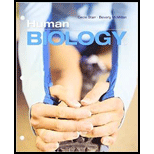
Bundle: Human Biology, Loose-leaf Version, 11th + MindTap Biology, 1 term (6 months) Printed Access Card
11th Edition
ISBN: 9781305616660
Author: Cecie Starr, Beverly McMillan
Publisher: Cengage Learning
expand_more
expand_more
format_list_bulleted
Concept explainers
Textbook Question
Chapter 9, Problem 10SQ
Match the immunity concepts:
__________ inflammation
__________ antibody secretion
__________ phagocyte
__________ immunological memory
__________ vaccination
__________ allergy
- a. neutrophil
- b. plasma cell
- c. nonspecific response
- d. purposely causing memory cell production
- e. basis of secondary immune response
- f. nonprotective immune response
Expert Solution & Answer
Want to see the full answer?
Check out a sample textbook solution
Students have asked these similar questions
The following table is from Kumar et. al. Highly Selective Dopamine D3 Receptor (DR) Antagonists and Partial Agonists Based on Eticlopride and the D3R Crystal Structure: New Leads for Opioid Dependence Treatment. J. Med Chem 2016.
The following figure is from Caterina et al. The capsaicin receptor: a heat activated ion channel in the
pain pathway. Nature, 1997. Black boxes indicate capsaicin, white circles indicate resinferatoxin.
You are a chef in a fancy new science-themed restaurant. You have a recipe that calls for 1 teaspoon of resinferatoxin, but you feel uncomfortable serving foods with "toxins" in them. How much capsaicin could you substitute instead?
What protein is necessary for packaging acetylcholine into synaptic vesicles?
Chapter 9 Solutions
Bundle: Human Biology, Loose-leaf Version, 11th + MindTap Biology, 1 term (6 months) Printed Access Card
Ch. 9 - Prob. 1RQCh. 9 - Distinguish between a. neutrophil and macrophage...Ch. 9 - What is the difference between innate immunity and...Ch. 9 - What is the difference between an allergy and an...Ch. 9 - ______ are barriers to pathogens at body surfaces....Ch. 9 - Complement proteins function in defense by...Ch. 9 - Prob. 3SQCh. 9 - Prob. 4SQCh. 9 - Antibody-mediated responses work best against...Ch. 9 - Cell-mediated responses work best against...
Ch. 9 - The most common antigens are __________. a....Ch. 9 - The ability to develop a secondary immune response...Ch. 9 - Tears are part of the bodys defensive arsenal....Ch. 9 - Match the immunity concepts: __________...Ch. 9 - New research suggests a link between some microbes...Ch. 9 - Given what you now know about how foreign invaders...Ch. 9 - Researchers have been trying to develop a way to...Ch. 9 - Prob. 4CTCh. 9 - Prob. 5CT
Knowledge Booster
Learn more about
Need a deep-dive on the concept behind this application? Look no further. Learn more about this topic, biology and related others by exploring similar questions and additional content below.Similar questions
- 1. Match each vocabulary term to its best descriptor A. affinity B. efficacy C. inert D. mimic E. how drugs move through body F. how drugs bind Kd Bmax Agonist Antagonist Pharmacokinetics Pharmacodynamicsarrow_forward50 mg dose of a drug is given orally to a patient. The bioavailability of the drug is 0.2. What is the volume of distribution of the drug if the plasma concentration is 1 mg/L? Be sure to provide units.arrow_forwardDetermine Kd and Bmax from the following Scatchard plot. Make sure to include units.arrow_forward
- Choose a catecholamine neurotransmitter and describe/draw the components of the synapse important for its signaling including synthesis, packaging into vesicles, receptors, transporters/degradative enzymes. Describe 2 drugs that can act on this system.arrow_forwardThe following figure is from Caterina et al. The capsaicin receptor: a heat activated ion channel in the pain pathway. Nature, 1997. Black boxes indicate capsaicin, white circles indicate resinferatoxin. a) Which has a higher potency? b) Which is has a higher efficacy? c) What is the approximate Kd of capsaicin in uM? (you can round to the nearest power of 10)arrow_forwardWhat is the rate-limiting-step for serotonin synthesis?arrow_forward
arrow_back_ios
SEE MORE QUESTIONS
arrow_forward_ios
Recommended textbooks for you
 Medical Terminology for Health Professions, Spira...Health & NutritionISBN:9781305634350Author:Ann Ehrlich, Carol L. Schroeder, Laura Ehrlich, Katrina A. SchroederPublisher:Cengage Learning
Medical Terminology for Health Professions, Spira...Health & NutritionISBN:9781305634350Author:Ann Ehrlich, Carol L. Schroeder, Laura Ehrlich, Katrina A. SchroederPublisher:Cengage Learning



Medical Terminology for Health Professions, Spira...
Health & Nutrition
ISBN:9781305634350
Author:Ann Ehrlich, Carol L. Schroeder, Laura Ehrlich, Katrina A. Schroeder
Publisher:Cengage Learning



7 Freudian Defence Mechanisms Explained; Author: Lewis Psychology;https://www.youtube.com/watch?v=fTnjJ105ze4;License: Standard youtube license